- This article comprehensively
tells you about the different forms of art, dance, crafts, poetry, music and
textile traditions of Maharashtra.
The land of Maharashtra is known
for its varied, vibrant and vivacious culture. A land that was guarded by the
invincible and beloved warrior-king Shivaji Maharaj and nourished by the great
Maratha rulers! The rich culture and simplistic, pragmatic lifestyle of people
of the state stem from its multitudinous arts and traditions that have been
revered and preserved over centuries. Despite heavy industrialisation and
modernization, there are several places in Maharashtra that have well-conserved
the traditional professions, arts, and crafts native to those regions.
Let us take a look at these arts
and crafts native to the state of Maharashtra.
1. Arts
& Crafts
Warli
Paintings
Warli paintings derive their name
from the Warli tribe which is the largest tribe found in Thane district,
present in the northern outskirts of Mumbai, Maharashtra.
Warli, the word, comes from warla, which means a piece of land or a
field. The daily and social life of the warli tribesmen is depicted through art
that is displayed on the walls of the village houses. The paintings depict
human figures engaged in activities like dancing, hunting, harvesting, sowing,
drying clothes, drawing water from wells and so on in a loose rhythmic pattern.
Warli paintings have now gained
popularity across the nation and are sold as prints on sarees, tiles, cloth,
and as wall paintings.
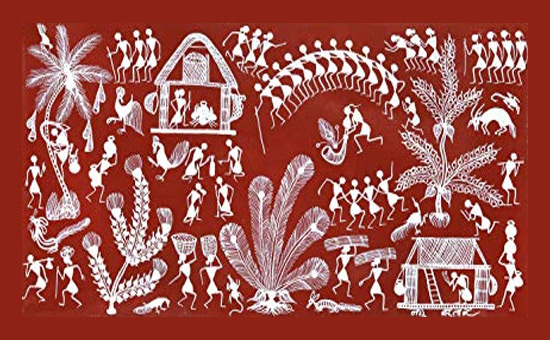 Warli Painting
Warli Painting
Sawantwadi
crafts
Sawantwadi, a quaint town located
along the western coastline of Konkan boasts of scenic beauty and lacquer
crafts. Motifs of leaves and flowers, and mythological figures are painted on
the surface of different objects. This lacquer craft has been extended to creation
of beautifully crafted lacquered furniture and light fittings.
It is sold across the country as
Sawantwadi crafts and has drawn a lot of international attention.
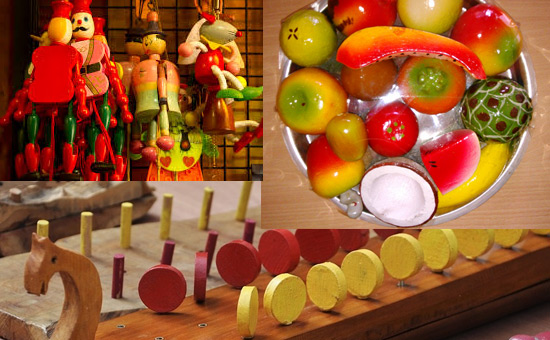 Sawantwadi craft
Sawantwadi craft
Bidriware
Bidriware crafts, native to the
city of Aurangabad, are very famous as souvenirs, hookahs, and paan holders.
They are made from a combination of zinc and copper. Pure silver is known to be
embossed, inlaid or overlaid on various materials, preferably metal to look
like an intricate mosaic. These craft works are now available in various sizes
and shapes across the country.
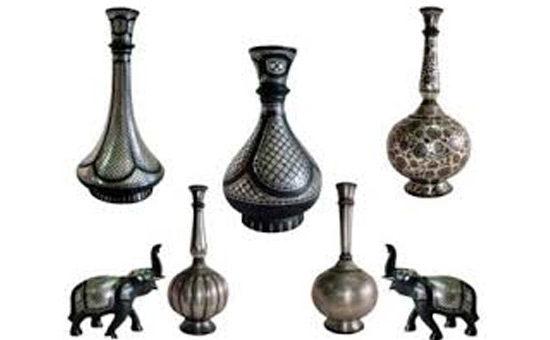 Bidriware.
Bidriware.
2. Cloth
and Sarees
Mashru
& Himru
The district of Aurangabad is
known not only for Ajanta & Ellora, and the Daulatabad fort, but also for
the famous fabrics of Mashru and Himru. These fabrics are made of cotton and
silk and have a satin-like appearance. Himru shawls are multi-coloured and are
prepared by the artisans from Benaras who set up the Himru industry in
Aurangabad, years ago. These fabrics are worth every penny they cost.
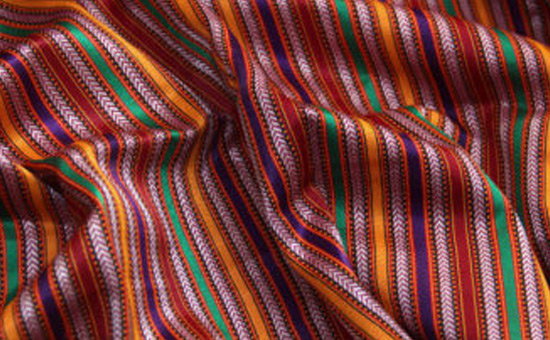 Mashru.
Mashru.
Paithani
sarees
Paithan, the religious town is
very well known for its Paithani saree weaving industry. This exquisite piece
of six and nine yards is made of pure silk and its beautiful brocaded
embroidery of zari is obtained from threads drawn from pure gold. An entire
saree could take approximately 6 months to 1.5 years to weave. The price range
is from a few thousand to a few lakh Indian rupees. For Maharashtrian women, a
paithani is a must-have piece of fabric in their trousseau.
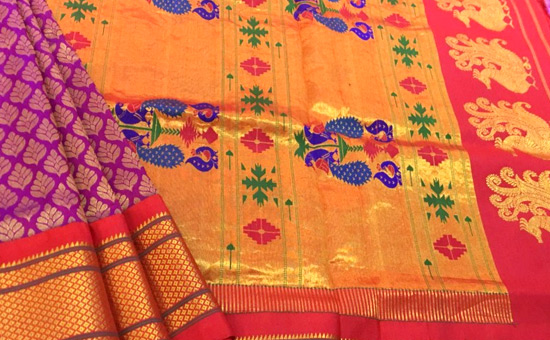 Paithani sari
Paithani sari
Narayan
Peth
The Narayan Peth saree of Solapur
is another popular traditional sarees from the state of Maharashtra. It is
woven in pure silk with a contrasting zari border. The saree derives its
uniqueness from the beautiful rudraksha motifs present on it. Although it is
not as expensive as the Paithani, it cost up to several thousands of Indian
rupees.
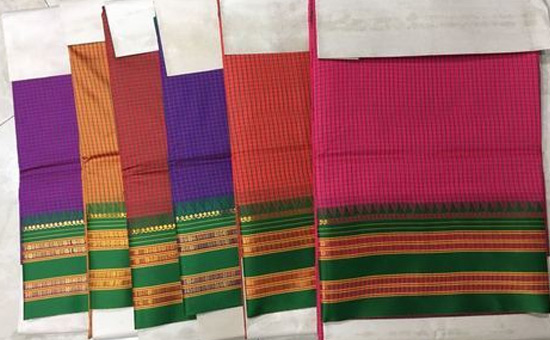 Narayan Peth sari.
Narayan Peth sari.
3. Jewellery
& Accessories
Kolhapuri
Jewellery
The district of Kolhapur is renowned
for its unique jewellery seeped in culture and royalty. The most loved among
these adornments is the Kolhapuri saaj, a necklace like no other. Other popular
pieces of jewellery from the land of Kolhapur are the Har, Mohanmal, Bormal,
Chaplahaar, Pohehaar and Putlihaar.
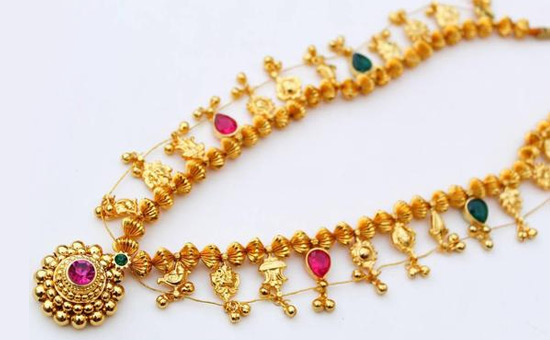 Kolhapuri saaj.
Kolhapuri saaj.
Kolhapuri
chappals
These beautiful leatherworks footwear
called Kolhapuri chappals are native to royal district of Kolhapur. The
chappals offer a unique style and are extremely comfortable. Such is the
popularity of the Kolhapuri chappals that they are exported the world over.
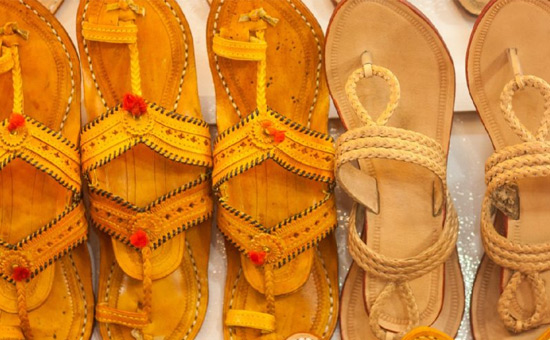 Kolhapuri chappal.
Kolhapuri chappal.
4. Music
of Maharashtra
The art forms of dance and music
are intricately woven in the fabric of the Maharashtrian culture and tradition.
Did you know that the musical instrument Sitar is made in the city of Miraj
near Sangli district?
The city of Miraj has been honoured with the title of ‘town of
music’ for this significant contribution to classical music. There are three major forms of music at the core of the musical history of the state such as folk music, natya sangeet, and the poetry of the saints. Let us take a deeper look at these forms of music.
Folk
Music
Ordinary village folk have significantly
contributed to folk music in Maharashtra.
Povadas are ballads which describe the life, times,
and significant events in the life of Chhatrapati Shivaji Maharaj. Povadas are
enjoyed by all villagers given their informational and inspirational content.
Take a look at one of the most
popular Povadas
from a recent commercially successful and critically acclaimed Marathi movie.
Owi, a typical folk song, made up of couplets describing women’s maternal and marital homes, is sung by village womenfolk while performing routine chores throughout the day. Married women, called suvasinis sing songs of marital bliss
and marital responsibilities during haladi & ghana bharane ceremonies (ceremonies
where women apply home-ground turmeric paste on the soon-to-be-wedded bride and
bridegroom).
The most exciting form of music
is Bhaleri, which is sung by farmers while
working in their fields. Bhaleri has diverse verses and words during different
seasons like sowing, harvesting, and reaping.
Palane is a song that Maharashtrian women
sing as a lullaby to put their children and toddlers off to sleep.
Women also sing Artya during epidemics, to
appease gods and goddesses to cure those suffering from deadly diseases.
Several other forms of simple devotional
music like bhajans, bharud, gondhal, kirtans, lalita, abhanga, and tumbadi which
were composed to praise Hindu Gods and regional deities have contributed immensely
to the rich musical canvas of Maharashtra.
Natya
Sangeet
Marathi Natya Sangeet is a semi-classical
style of music derived from Hindustani classical music. It is performed on
stage during plays/dramas. The legendary dramatist Vishnudas Bhave was a
pioneer of Marathi theatre. Annasaheb Kirloskar, known as the father of modern
Marathi theatre was the stalwart who introduced music into theatre thereby starting
the tradition of Natya Sangeet. Since then Marathi Natya Sangeet has been
through several transformations and has evolved as the most engaging mediums
for music and theatre lovers to date.
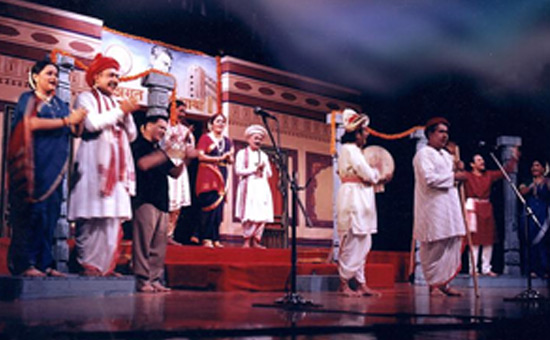 Natya Sangeet.
Natya Sangeet.
5.
Poetry of the saints
The poets and saints of
Maharashtra are highly revered due to their preaching through the combination
of bhakti (devotion) and gyana (knowledge). Some of the most noted poet-saints
are Dnyaneshwar, Tukaram, Namdev, Chokha, Soyarabai, Muktabai, and Savanta. They
came from diverse social backgrounds.
Dnyandev,
better known as Dnyaneshwar wrote the Dnyaneshwari
which is a monumental verse commentary on the holy Bhagavad Geeta.
Namdev,
a reformed criminal, rose to popularity when he started composing devotional
songs in Marathi and Hindi. It is interesting to note that some of the songs
written by Namdev in Hindi are also included in the Adi Granth.
Women saints like Muktabai, the sister of Dnyandev, also made notable
contributions to Marathi poetry and devotional preaching. She composed 41 abhangas
in her lifetime in devotion toward Vithoba.
Several other saints who carried
on the good work initiated by Dnyaneshwar are Tukaram, Bahinabai, Eknath, and Rameshwar.
Notable among these are the hauntingly painful, lyrical, and melodious
compositions by Bahinabai, a warkari poet-saint which mirror her dilemma of
duty toward her husband and her devotion to Vithoba.
Samartha
Ramdas Swami is one of the most powerful saints in Maharashtra who is
known to have inspired Shivaji Maharaj in his struggle for Swaraj. His
compositions Manache Shlok and Dasbodh are revered by generations to
date.
In essence, poetry, devotion, and
positive intent of these saints was bound in the rustic music of those times.
Several musicians now find creative inspiration in those simple lyrical notes
to compose contemporary music for the masses.
6. Dances
of Maharashtra
Like music, dance too is
ingrained in the Maharashtrian psyche. Vibrant folk and traditional dances make
up a beautiful mosaic of Marathi culture. Let us take a look at some of the
popular dance forms.
Lavani
Lavani, the most popular dance
form of Maharashtra derives its name from Lavanya, which is translated as
beauty. It is performed by beautiful women wearing nine yards sarees and
dancing to the beats of a drum-like instrument called dholak. The movements are
gyrating and spiral and involve intricate leg and hip movements.
The lavani is a traditional dance
form which earlier depicted the life of the ordinary people, society, overall.
It later went on to be performed for the tired soldiers of the Maratha battles
and further on came to be misused for the entertainment of influential people.
The disrepute gained in this process maligned the dance form for a few years
but it was eventually revived by several great poets and reformers and its lost
glory was thereby reinstated.
Today, lavani is performed in the
baithi (sitting position) form also in addition to the traditional standing
position. To see Video of Top 8 Lavani songs.
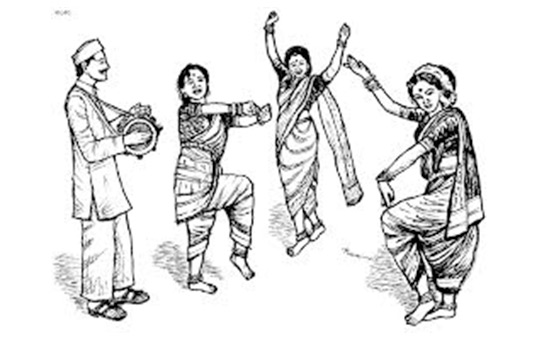 Lavani dance.
Lavani dance.
Tamasha
Tamasha, the most popular form of
folk theatre in Maharashtra owes its name to the Persians as Tamasha literally
means entertainment or fun. The Mahar and Kothari communities in Maharashtra
have contributed to the evolution of this dance form since the 16th
century AD.
Love songs are known to play a
vital role and form the crux of this dance form. It is performed to the beats
of several instruments like the dholak, cymbals, tuntuni, halgi, kade,
ghunghroos, lejim, and harmonium. The musical aspect of the tamasha is believed
to be inspired by Bhana and Prahsana, two forms of Sanskrit drama.
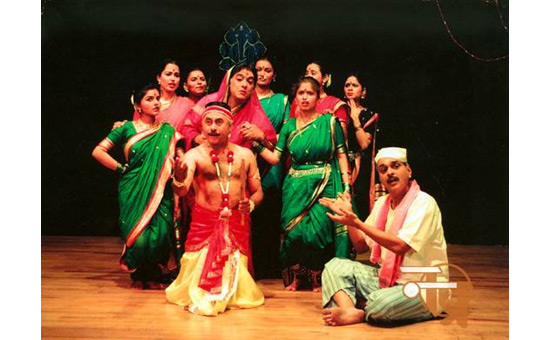 Tamasha.
Tamasha.
Koli
dance
Koli dance is performed by the fishermen community of Maharashtra. It showcases the vivacity of the community and is therefore termed as a ‘dance of joy’.
Both men and women, either
standing together in a single row or by forming pairs perform dance movements,
depicting activities performed during fishing such as rowing boats, casting
nets, symbolically forming waves, swaying oars in forward and backward motions,
and so on.
Vibrant garments and jewellery
distinctive of the fisher-folk community, enhance their dance! The koli dance
is specifically performed during the Narali
Purnima festival to appease the sea god to calm the seas in order for the
fishermen to resume fishing and earn their yearly monetary compensation.
 Koli dance
Koli dance
Dindi
It is dance form that is popularised by the ‘Varkaris’, a devotional sect, and chronicles the playful attitude of Lord Krishna. An mridangam player and a vocalist provide the necessary beat and musical background to the dance that is performed by both men and women together. Dindi
is typically performed on the Ekadashi day of the holy month of Kartik.
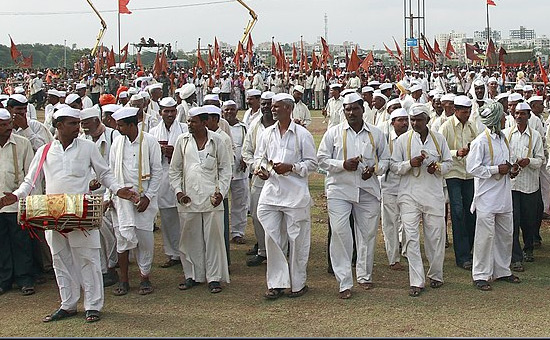 Varkaris
Varkaris
Dhangari
Gaja
Dhangari gaja, as the name
suggests is a peculiar dance performed by the Dhangar (shepherd) community of
the district of Solapur. Since the shepherds earn their living by grazing goats
and sheep, they are truly inspired by nature that surrounds them while grazing
the cattle.
Songs are dedicated to nature, in the form of couplets – the Ovis. Their songs also refer to the stories surrounding the birth and life of their god ‘Biroba’. Dhangari gaja is performed by a group of men dressed in traditional Marathi attire of angarkha, dhoti, pheta, and colourful handkerchiefs. There are dholak players who are surrounded by these dancers.
Kala
This is another regional dance
form, little is known of it. It is performed in obeisance to Lord Krishna and
represents the joyous and playful mood of the God. The most unique feature of
this dance form is the presence of a pot which symbolises fertility. The dance
revolves around this pot and is performed by men and women together.
A diverse geographical landscape,
historically important events, social diversity of the population of
Maharashtra, and a healthy interaction with neighbouring states among other
reasons have all contributed to the preservation of its original arts and
crafts, and incorporation of several new and improved arts and crafts into its
fold. Every different region and city
has its significance and has contributed vastly to the evolution and progress of
the state as a financial and cultural capital of the country.
Also read
1. About
Warli Art
2. Paithani
Saris pictures at Paithan
3. Marathi
Natya Sangeet